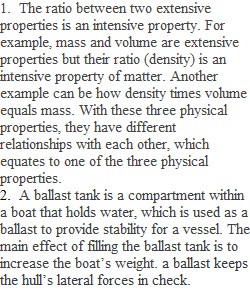


Q This assignment supports the following Unit Objectives: • (U30) Determine the factors that affect density (CLO4) • (U31) Use the Density Formula (CLO2) • (U32) Recognize and use appropriate units for density (CLO2)(CLO4) • (U33) Rank items according to densities (CLO2)(CLO4) • (UDS) Develop a well thought out and correct response to various discussion questions(CLO2) (CLO4)(Goal 4) Do not start a new thread. Simply reply to my posting. Be sure to comment on at least two of your classmates' postings. Your replies must be more than a simple phrase like "I agree" or "I like your answers". Replies should reflect on why you agree or like what has been posted. Your replies must reflect a genuine effort to engage your fellow classmates regarding the comments provided or the problem that has been solved. Post your replies to the following questions here. 1. All physical properties (including mass, volume, and density) are classified as either intensive (independent of amount) or extensive (dependent on amount). Explain how using two extensive properties (mass and volume), we get two intensive properties. 2. Ships use ballast to ensure that they float at a proper height. How does ballast work to stabilize a ship in terms of its position in reference to the surface of the water? 3. Part of swimming instruction is teaching swimmers to float on their backs. Is it easier to float when your lungs are relatively full or empty? Explain. 4. What conclusion(s) can you draw from this experiment?
View Related Questions